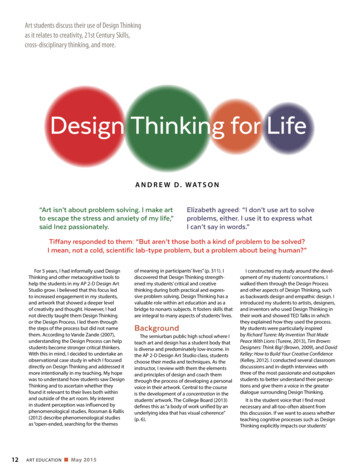
Transcription
QQ Design Pack Systems ThinkingDesign PackSystems ThinkingWhat if your students were empowered to tackle difficult problems withintheir lives, their communities, and the world at large? What if they could figureout how the factors of a problem are related, and use that knowledge to affectpositive changes? What if they left your class as agents of change?From the experts in systems thinking and learning at Quest Schools, this designpack is full of tools and resources you’ll need to begin or expand the integrationof systems thinking into your classroom.Version 1.0www.instituteofplay.orgpg. 1
Q Design Pack Systems ThinkingSystems thinkingmeans understandinga system by examiningthe linkages andinteractions betweenthe elements thatcompose the entiretyof the system.That is the core of systems thinking. And withthis type of thinking, students and teacherscan learn to make positive changes in systems.www.instituteofplay.orgpg. 1
Q Design Pack Systems ThinkingWhat is a System?Before digging into the details of systems thinking,let’s look at what a system is and what it isn’t.This is a heap.Not a system.This is a system.Nothing changes whena part is taken away or addedto this heap.Change definitely happensif you add or take awaya part of this system.Resource: Waters Foundation, 2013www.instituteofplay.orgpg. 2
Q Design Pack Systems Thinkingpg. 3How does a SystemsThinker Think?Students wonder how to keep theirschool from being closed.NOT A SYSTEMS THINKERA SYSTEMS THINKER Think of 1-2 reasons why the schoolis being closed. Talk to the principal about thosereasons and see if he can stop theschool from being closed. List all factors that are involved in deciding to close the school. Group the factors according to similarities. Identify the largest group of factors and create a map of those factors showinghow they are related to one another. Find places on the map where a specific change might improve the school. Share and present these changes at a school board meeting.You wonder how you can stopfeeling so tired every day.NOT A SYSTEMS THINKERA SYSTEMS THINKER Decide to drink more coffee toincrease energy. List all factors that are involved with your tiredness.Diagram how drinking coffee affects your energy as well as sleep.Identify that coffee interferes with your sleep and that makes you more tired.Decide to stop drinking caffeine.Teachers wonder how to lower hallwaynoise during passing periods.NOT A SYSTEMS THINKERA SYSTEMS THINKER Decide to increase schoolsecurity guards in the hallwayduring passing time. List all factors that contribute to hallway noise, such as number of teachersin the hallway, number of students waiting to enter classrooms, number ofstudents in bathrooms, etc. Map how all these factors are related to hallway noise and each other. Identify 1-2 factors from the map to change to see if hallway noise will lessenas a result.www.instituteofplay.org
Q Design Pack Systems Thinkingpg. 4How do I use thisSystems Thinking Design Pack?At our Quest schools, teachers and Institute of Play staff use the tools in thisSystems Thinking Design Pack to support teachers and students in buildingknowledge and skills in systems thinking. We invite you to explore and playtestthese tools in your own teaching and learning. After reading what is in thisdesign pack, decide where you want to start.Here’s what is in this pack.16Introduction SystemsWe begin this designThinkingpack describingMechanicswhat systems thinkingis and how systemsthinkers think.To really understandsystems thinking, wehave to understandmore about whysystems thinking isimportant to learn.7 What is SystemsThinking?8 Why SystemsThinking?9 Systems ThinkingHabits of Mindwww.instituteofplay.org10SystemsThinkingin SchoolsReading about whatsystems thinking lookslike in a school will helpyou integrate systemsthinking into yourteaching and school.111415In the ClassroomSystems Thinkingin Quest SchoolsSystems Thinkingand StandardsLook fortips & notesfor teachersand gamedesigners.TEACHING TIPGAME DESIGN HINT18SystemsThinkingToolkitTo understandsystems thinking, it isessential to learn howto examine problemsusing systems thinkingtools. By learningthrough doing, you willunderstand the valueof this type of thinkingfor yourself and yourstudents.22263034Behavior OverTime GraphCollect and ClusterFeedback LoopsCausal Maps40GoingFurtherWe share moreresources for you touse to dive deeper intosystems thinking andhow to integrate it intoschools.41 Reflection42 Appendix43 ContinuedLearning
Q Design Pack Systems ThinkingSystemsThinkingMechanicsTo understand why systems thinkingis an essential 21st century skill,it is important to learn more aboutsystems thinking—what it is and howwe use it.www.instituteofplay.orgpg. 5
MechanicsQ Design Pack Systems Thinkingpg. 6What is Systems Thinking?Systems thinking is looking at things as a wholerather than a jumble of parts.“[Systems thinking] isunderstanding a world ofinterdependence and thingscontinually changing. How doyou see a system and not justa bunch of isolated things?—Peter Senge, 2013Using a systems thinking tool, students work with their teacher to examine a complex problem.We believe it is essential to helpyoung people understand how systemswork, how they are represented, howthey change—via direct or indirectmeans—and how to ask “what if ”questions about future outcomes. Weuse systems thinking as a frameworkand set of tools to help students developthinking skills that empower them towww.instituteofplay.orgexplore and understand complexproblems.So, what is a system? A system,human-made or natural, exists andfunctions as a whole through thedynamic interaction of its independentparts. When one part of a systemchanges, it affects other parts ofthe system, and ultimately affectsthe stability and sustainabilityof the system. Different systemsinclude natural systems dealing withbiodiversity, political systems madeof associated institutions, economicsystems that drive production, andsocial systems governed by rules.
MechanicsQ Design Pack Systems Thinkingpg. 7Why Systems Thinking?Systems thinking enables people to lookat problems in new ways — and that leads tonew solutions.By now, you might have realized thatyou have used systems thinking in yourlife, but that you never called it systemsthinking. For instance, you may havetaken a long-distance view of a problemand then zoomed in to examine details ofthe problem to figure out what you couldchange to address the problem. This typeof thinking is systems thinking.By using systems thinking, studentscan better organize and make sense oftheir experiences. As systems thinkers,students better understand how changeswww.instituteofplay.orgin one part of a system can affect otherparts — everything is interconnected.Systems thinking also enables studentsto see patterns to help them organizetheir learning within and across contentareas, as well as their experiences inand out of school. The power of systemsthinking truly helps students buildself-confidence and self-agency byenabling them to examine and addresstough problems in their own lives, theircommunities, and possibly the world.“Systems thinking pushes kidsto really boost themselves upto think about a problem likethey normally wouldn’t.”— Quest studentGAME DESIGN HINTAt Quest schools, gamedesigners use systemsthinking as much asteachers and students.Looking at games assystems provides structurefor the design, critiqueand iteration of games.
MechanicsQ Design Pack Systems ThinkingSystems ThinkingHabits of MindSystems thinkers use numerous habits of mind forproblem-solving. These habits, which are useful inboth school and life, include the following:Seeking to understand the big pictureSeeing patterns/trends in systemsRecognizing how a system’s structurecauses its behaviorIdentifying cause and effect relationshipsSurfacing and testing assumptionsFinding where unintended consequencesmight ariseFinding leverage points to change a systemResisting making quick conclusionsResource: Waters Foundation, 2013www.instituteofplay.orgpg. 8
Q Design Pack Systems ThinkingSystemsThinkingin SchoolsIntegrating systems thinking into schools enablesstudents to examine complex problems both insideand outside the classroom.www.instituteofplay.orgpg. 9
In SchoolsQ Design Pack Systems Thinkingpg. 10In the ClassroomWorking together, students try to break thesystem of bullying.Using a systems thinking tool, students work with their teacher to examine a complex problem.Step 1: Observe.“Jordan, would you mindsharing what you so courageously shared with me?”asked the teacher. Jordan, a7th grader, looked at his shoesand repeated what he hadsaid to his teacher. “I feel badly because I think I’ve been abully sometimes.”Step 2: Define a problem.Bullying is a widespreadproblem in schools. Jordanbravely acknowledged hisrole in the bullying problemas part of a weeklongimmersion course duringwhich Quest to Learnstudents created a campaignagainst bullying calledBreak the System.www.instituteofplay.orgStep 3: Zoom in.Identify the parts.At one point, noise of pensand pencils scribbling onPost-its filled the classroomas students wrote down asmany factors involved inbullying as possible. Studentsthen dropped to their kneesand clustered similar factorstogether on the floor in themiddle of the classroom.Looking down at the multicolored Post-its, studentsbegan to talk about relationships among factors in different clusters that they saw.Step 4: See relationships.Look for the patternsand trends.By looking at factors andtheir relationships, studentsnow saw bullying as a system.They quickly realized thatthey might be able to stopbullying by changing things inthe system of bullying. For instance, when kids don’t stopbullying when it happens,more students are bullied.And when more students arebullied, more kids don’t stopbullying when they see it happen. They knew they wantedto stop this cycle by helpingtheir peers and other kidsrealize the important role ofbystanders—to stop bullyingwhen it happens.Step 5: Identify leveragepoints. Break the system.Jordan led the charge ofcreating a Break the Systempledge that Quest to Learnstudents and faculty/staffcould sign. They also believed that middle schoolbullying might lessen if theytalked about bullying withyounger kids. So, the studentspresented about bullyingat neighboring elementaryschools. This group of students took a problem, useddifferent tools, and designedways to affect positive changeon bullying that was relevantto themselves, their community, and the larger world.
In SchoolsQ Design Pack Systems Thinkingpg. 11In the ClassroomReflectionSystems thinking enables students to seecommon structures and patterns within andacross content areas.A student created this pledge for all Quest students, staff and faculty to sign as one leverage point toaddress bullying in the school.After reading about the bullyingproject, how did that student thinkingdiffer from a learning experience in atypical classroom? The 12-year-olds inthis class approached a relevant problemto their lives using habits of mindthat enabled them to dig deep into theproblem to both understand it and createwww.instituteofplay.orgthoughtful and positive change.To think more about the value ofsystems thinking for youth, considerthis question: how would the Queststudents have addressed bullyingwithout using systems thinking? Wecan imagine students might have onlytaken the perspective of the bulliedinto account, or focused on addressingbullying in only their school community,or immediately jumped to a fast solution.None of those actions would havedramatically changed bullying in Questschools and possibly beyond.
In SchoolsQ Design Pack Systems ThinkingWe use systemsthinking as aframework tohelp studentsdevelop habits ofmind that empowerthem to creativelyexamine complexproblems.Systems thinking is an invaluable 21st century skillfor both youth and adults to use in educational andprofessional contexts, as well as in their daily lives.www.instituteofplay.orgpg. 12
In SchoolsQ Design Pack Systems ThinkingSystems Thinking inQuest SchoolsAt Quest schools, we strive to develop not onlysystems thinkers, but also systems citizens who viewthemselves as members of a global community.pg. 13“I found systems thinking to bean amazing tool for me, as aneducator, in breaking downlarge concepts that I wantedmy students to understand.”— Quest TeacherGRADE LEVELChange AgencyChange ntended ConsequencesFeedback LoopsChange/PatternsParts and Relationships1211109ththththHow might you envision a hopeful future and create it for yourself and your communities?How might you use systems thinking to benefit yourself and others?How might you use systems thinking to impact future generations?How might you use systems thinking to make choices in your life?How might we change dynamic systems?What makes a dynamic system?What is in a system?As systems citizens, Quest studentsstrive to understand the complexities ofsystems in today’s world, and to have theability to tackle problems systemicallyto make a positive difference. Webelieve that it’s not enough to instillthis competency in current leaders—wemust prepare the next generation to beeffective and thoughtful stewards of theworld they will soon inherit.To guide students in their systemsthinking/citizenship journeys, andteachers in designing this journey, wewww.instituteofplay.org876thththChange AgencyUnpredictability/ComplexityFeedback LoopsSustainabilityChange/PatternsParts and Relationshipsdeveloped a middle and high schooltrajectory of concepts and questions.Year-long systems thinking questionsand the corresponding concepts areconnected to relevant subject matterwithin classes. This connection helpsstudents understand how systemsthinking can be used in not only onecontent area, but all content areas.Applying the same thinking acrossdifferent classes helps students seeinterconnections among subject matter.The trajectory begins with morebasic systems thinking concepts andextends into more complex concepts.In 9th grade, students revisit conceptsfrom middle school, but they use a lensfocused on their own agency to makechange in their communities usingsystems thinking. Throughout all thegrades, Quest students repeatedly use avariety of systems thinking tools to helpthem both understand systems thinkingconcepts and apply systems thinking tonew problems.
In SchoolsQ Design Pack Systems Thinkingpg. 14Systems Thinkingand StandardsSystems Thinking provides ways of thinking and toolsto help students reach learning goals aligned withCommon Core and state standards.A foundational component ofpresent-day U.S. education is standards.Common Core and state standardscontain what needs to be learned bystudents, but they do not highlight howstudents learn the standards. Teacherswho use systems thinking and its toolsto support their students in how theylearn standards fully advocate for thewidespread use of systems thinking.First and foremost, systems thinkinghelps students make meaning of theirexperiences, both within and outside theclassroom. Using systems thinking tools,www.instituteofplay.orgstudents can take both birds-eye viewsand close-up views of complexity. And,in doing so, they come to understand theparts of a complex problem or conceptand the relationships among those parts.Understanding relationships and howa change in one part may impact otherparts gives students ways to supporttheir thinking with specific evidence.Argumentation and reading complextext are key aspects of the CommonCore ELA standards. Additionally,because of its graphical nature, systemsthinking enables students to make theirmental models—or how they think aboutdifferent concepts and constructs—visual. Creating representationsof concepts and understandingare foundational to Common Coremath standards.Lastly, by using systems thinkingtools, students begin to see structuresand patterns common acrossconcepts in different content areas.Seeing these common patternsand structures empower studentsto solve problems that mighthave seemed previously unsolvable.
In SchoolsQ Design Pack Systems Thinkingpg. 15What Makes a GoodSystems Thinking Problem?Here’s a checklist.Is the problem complex?If so, it is a good systems thinking problem.Do there seem to bemultiple potential solutions?If so, it is a good systems thinking problem.Is the problem relevant to students?If so, it is a good systems thinking problem.If you can Google the answer,it is NOT a good systems thinking problem.www.instituteofplay.org
In SchoolsQ Design Pack Systems Thinkingpg. 16Your TurnTo make learning about systems thinking morerelevant to you, let’s set you up to engage with thenext section of systems thinking tools.Reflection QuestionsTake a couple of minutes and think about at least two problems you faced recently or are facing, either personal orwork-related. Examples may be trying in vain to cut down on eating sweets or constantly feeling stressed about spendingtoo much time on work and not enough time with family and friends.Draw a picture, diagram, cartoon or whatever you want to represent thesetwo problems in thespace provided and we’ll return to them in a bit.After learning about systems thinking and how it is integrated into Quest classrooms and schools, your next step is tolearn about specific systems thinking tools and plan how to integrate them into your classroom.www.instituteofplay.org
Q Design Pack Systems ThinkingSystemsThinkingToolkitExplore and play with the tools that systemsthinkers use to tackle challenging problems.BEHAVIOR OVER TIMEFEEDBACK LOOPSCOLLECT AND CLUSTERCAUSAL MAPSwww.instituteofplay.orgpg. 17
In SchoolsQ Design Pack Systems Thinkingpg. 18Getting StartedThe best way to learn somethingnew is to jump right in .THE TOOLKITAfter learning about systemsthinking, it is difficult to immediatelyjump into teaching systems thinking.Some of us think systemically withoutrealizing it. But to teach systemsthinking requires naming this type ofthinking and teaching others to usesystems thinking tools. When studentsgain systems thinking habits of mindand tools, they are able to developmore deliberate strategies to tacklecomplex problems.After testing out several approachesto help teachers develop this mindset inorder to support them in helping theirstudents develop the same mindset,we discovered that the best entry pointto systems thinking is by sharing andusing a series of systems thinking tools.These tools help students build andstrengthen the habits of mind associatedwith systems thinking (listed on p. 9).www.instituteofplay.orgIn the next sections, we will introducethe systems thinking tools, field-testedin both Quest classroom lessons andprofessional development sessions,and their direct link to building specifichabits of mind for systems thinking.When Quest teachers were giventime to play with and practice using thesystems thinking tools, and supportedin implementing the tools into theirteaching, we found: Teachers were more apt to use thetools in their classrooms because theyspent time understanding their valueand becoming comfortable with them; Teachers saw how these tools canbe used across content areas; and Systems thinking became more prevalent in the school with more studentsengaged in using systems thinkingtools in many of their classes.Four systems thinking toolsare in this design pack—behavior over time graph,collect and cluster,feedback loop, andcausal map.Each tool section includes: a description of its use user directions sample answers to keyquestions topic integration ideas an exercise for you topractice using the toolIt is important to note thatwe did not create any ofthese tools, but adaptedthem for our use fromPeter Senge, the WatersFoundation and CreativeLearning Exchange.
In SchoolsQ Design Pack Systems Thinkingpg. 19Advice for TeachingTo enable students to successfully use systemsthinking tools, keep in mind these effectiveteaching techniques seen in all great classrooms.Always have exemplars of finishedproducts to show students.Model using a tool by thinkingaloud as you use the tool inan example.Circulate and check-in withstudents as they work.Establish norms and expectationsaround small and wholegroup discussions.Provide opportunities for studentsto see each others’ work.www.instituteofplay.orgTEACHING TIPWhen planning withsystems thinking tools,always remember toanswer these threequestions:1. What are the learninggoals for your students?2. How will using systemsthinking tools help themreach the goals?3. How will you knowthey reached the goals?(What are the studentoutcomes?)
In SchoolsQ Design Pack Systems ThinkingA teacher alwaysasks the samekey questionsso that studentsbegin to alwaysask the questionsof themselves andeach other whenusing each tool.The tool is only a powerful learning tool if studentsare asked to answer the questions, too. Repeateduse of the same questions in all different classescreates a consistent culture of use around thesystems thinking tools in a school.www.instituteofplay.orgpg. 20
In SchoolsQ Design Pack Systems Thinkingpg. 21Behavior Over TimeGraph (BOTG)A simple graph with horizontal (time) and vertical(changing factor) axes showing change over time.A student graphed his emotions during the past five days.Habits of MindSeeking to understandthe big pictureSeeing patterns/trendsin systemsSurfacing and testingassumptionswww.instituteofplay.orgStudents, working in pairs, carefullydrew two axes of a graph. “Now, decideif you are graphing your stress level overone day or three days or a week. Labelyour x axis based on what you decide,”instructed the teacher. A hum in theroom grew and grew as students drewtheir stress level graphs and began toshare their lives with each other. Afterseven minutes, the teacher said, “Time’sup! Let’s hang up our graphs on the wallsand get ready to have a gallery walkto look at everyone’s. These look great,guys.” Students hung up their graphsand slowly began to walk around theroom to look at their peers’ work. Afterthree minutes, students sat down andthe teacher asked, “Okay, did you seeany patterns in our stress levels overthe course of a day, three days or aweek?” 26 hands shot up immediately.Lesson Outcome: In Wellness class,students will write short analyses ofBOTGs (their own and a peer’s) with aspecific focus on highlighting patterns.
Toolkit Behavior Over Time Graph (BOTG)Q Design Pack Systems Thinkingpg. 22SAMPLE KEY QUESTION ANSWERSBehavior Over Time GraphsKey Questions What changed? My feelings changed.How did it change? I was happy ondays 1, 2, and 4. Then I was sad on day3 and angry on day 5.What changed?How did it change?Why did it change?Why is this change important?6Why did it change? On day 3, I leftmy science homework at homeand I got in trouble. On day 5, I leftmy homework at home again andbecause it happened again, I wasangry.Why is this change important?‘Cause I can see why I was sad andangry. I can try to remember myhomework every day. Or I can writemyself a note to make me yWednesday21Draw x andy axes.2Label x in unitsof time. Theunits of time thatyou choose willenable you to seedifferent patterns,so be thoughtfulabout the unitsyou choose.www.instituteofplay.org3Label y as factorbeing graphed.ThursdayTIMEFRAMEX4Create scale fory factor. Doesnot have to benumerical. Couldbe “more”/”less”,“hot”/ ”warm”/”cold.”5Create thegraph. If you don’thave exact data,use estimation increating the graph.6Answer the fourkey questions.
Toolkit Behavior Over Time Graph (BOTG)Q Design Pack Systems Thinkingpg. 23GAME DESIGNER HINTWAYS TO USE BOTGS :— Asking playtesters to trackfun, challenge, emotions,etc while they play— Creating a visual of thechallenge or emotive flowin a game during the timea player plays itTopic IntegrationSCIENCEIs climate change happening?MATHWhat is the best way to savefor college?ELA AND FOREIGN LANGUAGEHow does the author affectyour emotions as you readHarry Potter and the DeathlyHallows?TEACHING TIPWITH YOUR STUDENTS— Choose somethingrelevant to them to graph(e.g. stress levels, amountof sleep, or number of hugsover a week)— Brainstorm x and y axesvariables (the x axis isalways time)— Collaborate to findpatterns in the graph— Hypothesize aboutwhat the patternsmay representHISTORYHas war always been a part ofhuman civilization since thebeginning?WELLNESSHow does what you eat impacthow you feel?CLASSROOM MANAGEMENTHow do I make my lessonsmore engaging?EXTENSIONUse BOTG by asking studentsto include two or morefactors in their BOTG.The two BOTGs above show different student representations oftheir emotions. Above: The BOTG shows a student’s stress levelsand how they varied over three days. Below: A student’s BOTGshows changes in his feelings during one day.www.instituteofplay.org
Toolkit Behavior Over Time Graph (BOTG)Q Design Pack Systems ThinkingReflection QuestionsNOW TRY ITUse one of the personal/professional problemsthat you identified on p.17to create a BOTG.What did you discover from your Behavior Over Time Graph?Label the x and y axes.Choose your time framefor the x axis carefullyto help you identify anypatterns or interestingdata points.Answer the 4 keyquestions.What changed?How did it change?Why did it change?Why is this changeimportant?How do you imagine you could use this tool in your classroom?www.instituteofplay.orgpg. 24
ToolkitQ Design Pack Systems Thinkingpg. 25Collect and ClusterAn exercise to create a list of factors ina problem and then group them togetherto discover patterns.In history class, an 8th grade student lists factors involvd with preventing warbetween the U.S. and Iran on Post-it notes.Habits of MindRecognizing how asystem’s structurecauses its behaviorSurfacing and ic sanctions,” yelled one 8thgrade student while another said, “SendUN inspectors” One student in thegroup busily wrote the two ideas on twodifferent Post-its. “What else?” asked thestudent. In the room, all students wereengaged in generating a list of factorsinvolved in preventing a war between theU.S. and Iran.After five more minutes, the teachersaid, “All eyes up here.” She went onto explain she wanted each studentgroup to put their Post-its, ranging innumber from 15-18, on chart paper.Then, students were given the challengeof grouping the Post-its based onsimilarities that they established. A flurryof movement erupted with hands raisingbrightly colored Post-its and studentsdiscussing their reasons for why theywere grouping different Post-its together.Lesson Outcome: In History class,students will identify different typesof factors/strategies involved inpreventing wars.
Toolkit Collect and ClusterQ Design Pack Systems Thinkingpg. 26SAMPLE KEY QUESTION ANSWERSCollect and ClusterKey QuestionsWhy did you cluster your post-itslike you did? We clustered our postits into good and bad groups. Why did you cluster your Post-its as you did?6 How did clustering the Post-its help you beginto explore the problem?How did the clustering help you tostart to explore the problem? Wewanted to look more at good actions,not bad ones for the people in Iran,that could prevent the war. Now wecan focus on those ones in our workWhat are the factors and clustertitles you came up with? Wenamed our groups of Post-its: Badand good actions and bad and goodconsequences. You can see on ourposter (see graphic below) all thefactors that we put in each group.PREVENT WAR WITH IRANBad actionsBad consequencesGood actionsGood consequences1Identifyproblem.2Using Post-its,list all factorsthat may affectthe problem onseparate Post-its.www.instituteofplay.org3Put post-its ona wall or table.4Cluster similarPost-its together.5Try to titleeach cluster ofPost-its to indicatecommonality.6Answer thetwo keyquestions.
Toolkit Collect and ClusterQ Design Pack Systems ThinkingGAME DESIGN HINTTopic Integration IdeasSCIENCEWhy doesn’t the pond nearour school have any fish in it?MATHHow are the money savingpatterns similar or differentbetween low-income, middleclass, and the wealthy?USE COLLECT & CLUSTER :— Brainstorm game ideasaround titles, game features,goals, and design— Use during a playtest tobrainstorm how to improvethe game after it is played.ELA AND FOREIGN LANGUAGEHow are Shakespeare’scharacters similar or differentfrom some of your favoritemovie/TV/book characters?HISTORYHow do governmentsmonitor their citizens intoday’s society?What about in the past?WELLNESSHow do food companiesconvince you to buytheir food?TEACHING TIPWITH YOUR STUDENTS— Practice collecting andclustering with an easyexercise (e.g. everyonethrows a shoe in the centerof the classroom and studentgroups classify the shoes)— Identify 1-2 most popularcategories from all studentgroupings— Encourage students towrite as many of their ideason Post-its as possibleCLASSROOM MANAGEMENTWhat influences studentengagement in my classroom?Above: An 8th grade student writes down factors that he thinks are involvedin preventing a war with Iran. Below: Then, in groups, students clustered theirfactors according to similarities and explained their groupings to their teacher.www.instituteofplay.orgpg. 27
Toolkit Collect and ClusterQ Design Pack Systems ThinkingReflection QuestionsNOW TRY ITTake the problemthat you used to createa BOTG.What did you discover from your Collect and Cluster exercise?Write the problemon big sheet of paper.Write out parts/factorsof that problem on Post-itsCluster similarparts/factors.Answer thesetwo questions:1) Why did you cluster yourPost-its as you did?2) How did clustering thePost-its help you begin tosolve the problem?How do you imagine you could use this tool in your classroom?www.instituteofplay.orgpg. 28
ToolkitQ Design Pack Systems Thinkingpg. 29Feedback LoopA diagram showing how at least
Systems Thinking Design Pack to support teachers and students in building knowledge and skills in systems thinking. We invite you to explore and playtest these tools in your own teaching and learning. After reading what is in this design pack, decide where you want to start. GAME DESIGN HINT TEA










